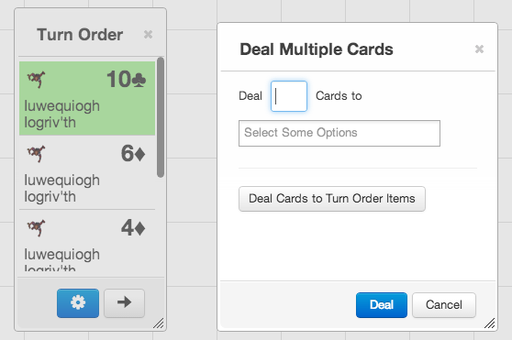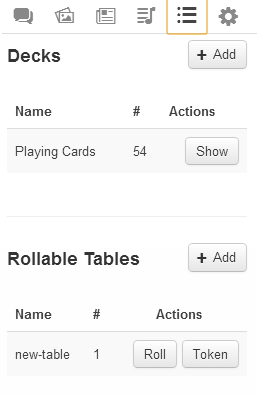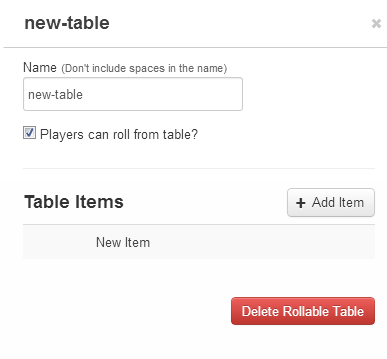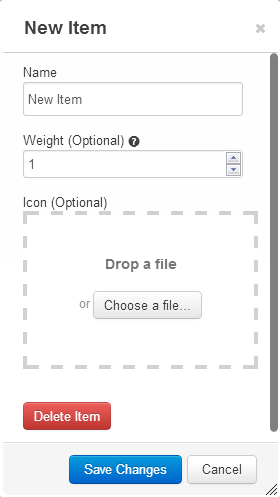Jeux de cartes et tables de jets
From Roll20 Wiki
Contents |
Jeux de cartes
Dans Roll20, les jeux de cartes correspondent à un ensemble de une ou plusieurs cartes pouvant être mélangées, tirées, distribuées aux joueurs, et jouées sur la table de jeu. Vous pouvez gérer les jeux de cartes de votre campagne dans l'onglet "Decks & Tables".
Chaque campagne possède un jeu de cartes jouables standard prêt à être utilisé. Vous pouvez également cliquer sur le bouton "Add" à côté de l'en-tête "Decks" pour créer votre propre jeu de carte personnalisé.
Voici deux screencasts montrant le système de jeux de cartes dans Roll20. Le premier est une vue d'ensemble et le second est un peu plus poussé. Des informations plus détaillées se trouvent en-dessous.
Masquer/Afficher un jeu de carte
Par défaut, les jeux de cartes sont cachés. Si vous souhaitez interagir avec un jeu, cliquez sur le bouton "Show". Le jeu apparaîtra dans le coin inférieur droit de la table de jeu, et sera visible par les joueurs et le GM en fonction des paramètres du jeu.
Tirer des cartes
Survolez le jeu de carte pour interagir avec celui-ci. L'action la plus courante consiste à tirer la prochaine carte du paquet, ce que vous pouvez faire en cliquant simplement vers le haut du paquet, là d'où la prochaine carte sort "discrètement". La carte sera tirée et montrée au-dessus du paquet à tous ceux ayant la permission de voir le deck.
Jouer des cartes
Pour jouer une carte du paquet sur la table de jeu, glissez/déposez la carte que vous venez de tirer (au-dessus du paquet, face ouverte) vers la table de jeu. Elle apparaîtra alors comme un jeton que vous pourrez déplacer et modifier comme un jeton classique. Vous pouvez également glisser/déposer la prochaine carte (celle sur laquelle vous cliqueriez pour tirer la prochaine carte) directement depuis le dos du paquet vers la table de jeu. Cela aura pour effet de jouer la carte sans avoir à la révéler auparavant.
Maintenez la touche Shift (Maj) enfoncée lors d'un glisser/déposer d'une carte vers la table de jeu la jouera face cachée au lieu de face ouverte (qui est l'option par défaut). Vous pouvez également effectuer un clic droit vers une carte déjà jouée pour la retourner face cachée ou ouverte.
Distribuer des cartes
Il est également possible de distribuer des cartes aux joueurs. Cela leur permet d'avoir un ensemble de cartes dans leur "main" comme autour d'une vraie table de jeu. Pour ce faire, glissez/déposez une carte depuis le bas du paquet (comme pour tirer une nouvelle carte) ou le haut du paquet (pour distribuer une carte visible) vers le nom du joueur dans le coin inférieur gauche de la table de jeu. Vous pourrez alors voir une petite icône représentant le paquet apparaître au-dessus de l'avatar du joueur avec un nombre représentant le nombre de carte que possède ce joueur.
Si vous souhaitez distribuer plusieurs cartes d'un coup, vous pouvez utiliser l'option "Deal" (Distribuer) du menu du paquet de cartes qui apparaît lorsque vous le survolez. Cela vous permettra de distribuer plusieurs cartes à chaque joueur (ou à des joueurs en particulier) d'un coup.
Les joueurs peuvent également récupérer des cartes ayant été jouées sur la table en effectuant un clic droit dessus puis en sélectionnant l'option "Take Card" (Prendre la carte).
Si vous voulez récupérer les cartes que vous avez distribuées et jouées, vous pouvez cliquer sur le bouton "Recall" (Récupérer) dans le menu du paquet de carte qui apparaît lorsque vous le survolez. Vous pourrez alors récupérer les cartes depuis la table de jeu, les mains des joueurs ou celles qui ont été écartées (tirées mais pas jouées ou distribuées. Vous pouvez également mélanger le paquet en récupérant des cartes, ce qui modifiera l'ordre des cartes du paquet de façon aléatoire. Il existe également une option Shuffle (Mélanger) si vous souhaitez uniquement mélanger les cartes écartées sans récupérer celles des joueurs ou celles jouées (cela mélangera toutes les cartes de la "défausse", ce qui inclut toutes les cartes ayant été supprimées de la table ou qui n'ont jamais été jouées ou distribuées après avoir été tirées).
Using Cards for Initiative Order
Some games such as Savage Worlds, utilize a playing deck to manage initiative. A secondary option available from the Deal window is a button labeled "Deal Cards to Turn Order Items". If you have tokens added to the Turn Order, pressing this button will deal a card to each character there. You can also drag a single card to the turn order by turning it over atop the deck and then clicking and dragging it to a character in the turn order. *Note: you should aim for the entry area that lists the turn order number. It will highlight in yellow if you're hovering in the right place. Otherwise Roll20 assumes you're dropping the card to the tabletop instead.Using Hands
After the players have been dealt cards and have one or more hands, they can click on the card icon above their avatar to open the hand. They can view the cards in their hand, as well as drag and drop to re-order their hand. They can also use the button at the top-right of their hand while it is open to view all the cards together or view the cards in their hand organized by deck. If they drag a card from their hand onto the tabletop, it will play the card onto the table, removing it from their hand.
Stealing Cards
Players can also open each other's hands, and by default they will only see the back of the other player's cards. If they mouseover a card in another player's hand, they have the option to "steal" that card. A dialog box will popup for the player they are stealing from to let them confirm the action. This is useful in games where players can steal from each other's hands, without seeing the card first.
Trading Cards
If a player drags a card out of their hand and onto another player's name, it will intiate a trade between the two players. The players will both see a dialog box which lets them add and remove cards from the trade, and when both have confirmed the trade is acceptable it will proceed.
Adding/Editing Decks
If you click on the name of the deck (in the deck listing of the My Settings tab), you'll open up a dialog box with additional options and settings:
Name: The name of the deck, shown when you mouseover the deck while it is visible
Show deck to players? If checked, players will see the deck and any cards drawn onto the top of the deck. If unchecked, only the GM will see the deck.
Players can draw cards? Determines whether players or only the GM can draw cards from the deck.
Cards in deck are infinite? If checked, the cards from the deck will never run out. Otherwise, once all cards have been drawn from the deck you'll need to recall and shuffle to keep drawing (just like a real physical deck).
In other's hands These options determine the visiblity of cards that are dealt to player hands. Number of cards means that the GM/player will see the number of cards in the player's hand. Front of cards means the GM/player can also see what the card is, instead of just the back of the card. By default the GM and players both see only the number of cards in players hands, but not what they are.
Discard pile The discard pile collects all cards which have been played and then removed from the tabletop (by deleting them), and all cards which are drawn but never played onto the tabletop or into a player's hand, are automatically added to the discard pile. These options allow you to determine how players may draw from the discard pile (by drawing only the single top/bottom card, or by choosing a card from the entire pile either by the back or face of the card).
Cards played on tabletop are played Determines if cards played from the deck and player's hands are played to the tabletop face up or face down by default. Holding the Shift key while playing a card will do the opposite of the default (e.g. play the card face-up if the default set here is face-down).
Card size on tabletop Determines the size that the cards are played to the tabletop at. If left blank, the system will automatically determine a size.
Adding/Editing Cards
Underneath the deck's options you will see a listing of each card in the deck. Click the "Add" button to add a new card, or click on the name of an existing card to edit it. Doing so will bring up a dialog box with additional settings for that card, which allow you to set the card's name and upload an image for the card, as well as a button to delete the card.
Below the listing of cards you will also see a place to upload an image to serve as the "back face" of all the cards for this deck.
Important Note: Your card faces and card back should all have the same dimensions for best results!
Rollable Tables
A rollable table is a collection of items from which a single item will be randomly chosen. It can be used to create custom dice, critical success/failure tables, loot tables, or any other list of items that need to be "rolled."
Starting a Rollable Table
Rollable tables are found under the right-hand Sidebar, under the "Decks and Tables" tab. To start a table, click "Add" and the interface will show you have a "new-table" with "0" items.
Editing your Rollable Table
Click on the name of the table, which again by default was "new-table". This will launch a pop-up screen, from which you can change the name of the table, toggle whether or not players can use this table, and add "items" to your table.
To add an item, click "Add Item," which will launch an additional pop-up screen. Similar to the last you can then name this item. By default, the name you enter will be shown in the chat box if this item is selected when the table is rolled.
If you are creating custom dice which have numeric values, enter a number into the name field. Otherwise you can enter any text you want.
If your rollable table has icons representing each item, or you are creating custom dice which have graphical sides, you can drag and drop an image into the Icon area. The icon you upload will be shown in the chat box if the item is selected during a roll.
You can additionally add "weight" to items in two methods; either enter the number of times you want the item be a possible result OR enter a percentage value. When using percentage values, do not place "%" after the number, and the final number of all items that are elements of the table must equal 100.
Using your Rollable Table
From the "Decks & Tables" tab of the Sidebar, you can simply click the "Roll" button to use your table, and the system will randomly select one of your "items" to show as the roll result. After rolling it once, it also shows up as one of your last ten rolls in the Dice Roller.
You can also roll a table directly in the chat input, or in a macro, by using the special roll command 1t[table-name]. For example, to roll your "crit-failure" table one time, you would enter /roll 1t[crit-failure]. You can change 1 to whatever number you would like.
If you have assigned icons to the items in your table, the table can also be used as a token. To do so, click the "Token" button in the list of rollable tables. Each click will generate a token on the table. Right clicking on that token you will see an option for "Multi-Sided." From here you can either select "Random Side" to generate a roll of this token OR select "Choose Side" to have this token show a specific image on the board.
Please note that changes to the rollable table are NOT reflected in a token already in the gameplay area. If you edit a rollable table and want those edits to be shown in your tokens, you will need to generate a new token.













